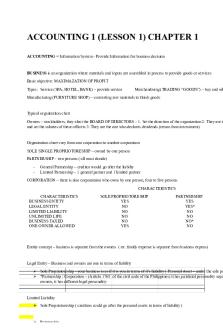1- Intro & Perspectives PDF

| Title | 1- Intro & Perspectives |
|---|---|
| Course | Abnormal Psychology |
| Institution | University of North Carolina at Chapel Hill |
| Pages | 3 |
| File Size | 74.1 KB |
| File Type | |
| Total Downloads | 38 |
| Total Views | 143 |
Summary
Ulku-Steiner...
Description
Introduction and Methods of Research Chapter 1 8/24 I.
How Do We Define Abnormal Behavior? a. Psychological Disorder i. Abnormal behavior pattern that involves a disturbance in psychological functioning or behavior ii. Prevalence keeps increasing b. Abnormal Psychology i. Branch of psychology dealing with the description, causes, and treatment of abnormal behavior patterns c. Criteria for Determining Abnormality i. Unusualness ii. Social deviance iii. Faulty perceptions of reality iv. Significant personal distress v. Maladaptive or self-defeating behavior vi. Dangerousness
II.
Cultural Bases of Abnormal Behavior a. Behavior that’s normal in one culture may not be normal in another b. Must take into account culture norms c. Ex: i. Flirting, praying, dieting, procrastinating, drinking alcohol, lying, hooking up, exercising, speeding, eating in the library
III.
Historical Perspectives of Abnormal Behavior a. Demonological Model i. Supernatural causes for abnormal behavior ii. Prominent in Western culture until Age of Enlightenment iii. Trephination 1. Prehistoric practice of cutting hole into skull to release demons b. Medical Model “Ill Humor” i. Humors 1. Vital bodily fluids a. Phlegm—lethargic b. Black bile—depression c. Blood—cheerful d. Yellow bile—quick tempered 2. Imbalance of humors caused abnormal behavior c. Witchcraft i. 15th – 17th century d. Asylums i. 15th – 16th century ii. public could buy tickets to see the antics e. Reform Movement i. Jean-Baptiste Pussin & Philippe Pinel & Dix ii. 18th – 19th
iii. People who suffer from these diseases should be treated humanely f. Deinstitutionalization i. State-hospitals to community-based treatment centers ii. Late 1950s g. Community Mental Health Movement i. Phenothiazines allowed schizophrenics to live somewhere other than a hospital IV.
Contemporary Perspectives of Abnormal Behavior: to provide framework & treatment a. Biological i. Griesinger 1. Abnormal behavior rooted in diseases of brain ii. Kraepelin 1. Mental disorders were like physical diseases iii. Paved way for modern medical model iv. Gained support in 19th century due to discovery of advanced stage of syphilis and dementia b. Psychological i. Charcot 1. Hypnosis to treat hysteria (unexplained paralysis / numbness) ii. Freud 1. Psychodynamic model a. Product of clashing forces in personality (subconscious) c. Sociocultural i. Failures of society rather than in the person 1. Racism, sexism, unemployment, gender, relationships d. Biopsychosocial i. Integrates all perspectives
V.
Research Methods in Abnormal Psychology a. Scientific method: examine theories and assumptions b. Theory: formulation of relationships between underlying events Naturalistic Observation a. Information on how subjects behave, but not why they do so Correlational Method a. Explains relationship between factors statistically b. Correlation coefficient i. Measures the strength of relationship between 2 variables (-1 +1) c. Ex: longitudinal study Experimental Method a. Cause and effect b. Random assignment c. Selection factor i. Bias in which differences between control and experimental groups is due to the participants, not the independent variable d. Internal validity i. Degree to which manipulation of independent variable is causally related to the dependent variable e. External validity
i. Degree to which results can be generalized to other settings f. Construct validity i. Degree to which treatment effects are due to the independent variable Epidemiological Studies a. Track rates of occurrence of disorders among different population groups b. Incidence i. Number of new cases within specific time period c. Prevalence i. Overall number of cases in a population within specific time period d. Random sample i. Used to increase likelihood of representative sample Kinship Studies a. Used to understand the role of heredity and environment in behavior b. Proband: first case diagnosed with particular disorder Case Study a. Biography based on clinical interviews, observations, and psychological tests b. Single-case experimental design a. Subject is used as his/her own control c. Reversal design a. Repeated measurement of a subject’s behavior through a sequence of alternating baseline and treatment phases...
Similar Free PDFs

1- Intro & Perspectives
- 3 Pages

CH 1- Perspectives on Sexuality
- 6 Pages

Feminist Perspectives
- 1 Pages

Theoretical Perspectives
- 3 Pages

Theoretical Perspectives
- 4 Pages

TEMA 1 Intro - Apuntes 1
- 2 Pages

Solutions-Chapter 1-Intro
- 7 Pages

Cours 1 - Intro
- 5 Pages

Intro study Guide 1
- 15 Pages

Introducción 1 - intro
- 2 Pages

Chaper 1 Intro - Apontamentos 1
- 9 Pages

Intro to calc 1
- 1 Pages

Intro Marketing Undad 1
- 30 Pages

Unit1 Intro-1 - pratice
- 3 Pages

Lecture 1 - intro - notes
- 67 Pages

Lezione 1 intro linux
- 41 Pages
Popular Institutions
- Tinajero National High School - Annex
- Politeknik Caltex Riau
- Yokohama City University
- SGT University
- University of Al-Qadisiyah
- Divine Word College of Vigan
- Techniek College Rotterdam
- Universidade de Santiago
- Universiti Teknologi MARA Cawangan Johor Kampus Pasir Gudang
- Poltekkes Kemenkes Yogyakarta
- Baguio City National High School
- Colegio san marcos
- preparatoria uno
- Centro de Bachillerato Tecnológico Industrial y de Servicios No. 107
- Dalian Maritime University
- Quang Trung Secondary School
- Colegio Tecnológico en Informática
- Corporación Regional de Educación Superior
- Grupo CEDVA
- Dar Al Uloom University
- Centro de Estudios Preuniversitarios de la Universidad Nacional de Ingeniería
- 上智大学
- Aakash International School, Nuna Majara
- San Felipe Neri Catholic School
- Kang Chiao International School - New Taipei City
- Misamis Occidental National High School
- Institución Educativa Escuela Normal Juan Ladrilleros
- Kolehiyo ng Pantukan
- Batanes State College
- Instituto Continental
- Sekolah Menengah Kejuruan Kesehatan Kaltara (Tarakan)
- Colegio de La Inmaculada Concepcion - Cebu